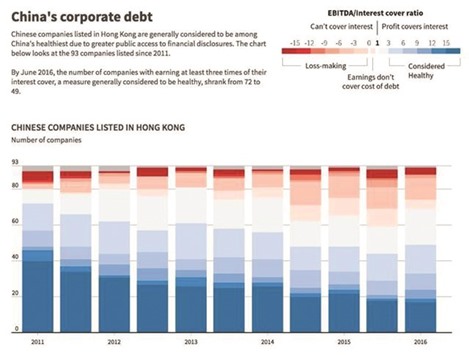China’s dependence on debt is growing at a “dangerous pace” and it must act to head off a brewing crisis, the IMF warned Tuesday.
The International Monetary Fund also said the country’s leaders should kick on with vital reforms or risk a painful correction in the world’s number two economy, adding that Beijing’s “unsustainably high” growth goals were adding to the problem.
While the country has made progress in its attempts to recalibrate the driver of growth, the Fund said failure to address structural issues could destroy that work.
The IMF’s warning comes weeks after a global central bank watchdog said China’s banking sector could be facing an imminent debt crisis, fuelling worries a blowout could send tremors through the world economy.
In an update to its World Economic Outlook, the IMF said: “China continues to make progress with the complex tasks of rebalancing its economy toward consumption and services and permitting market forces a greater role.
“But the economy’s dependence on credit is increasing at a dangerous pace, intermediated through an increasingly opaque and complex financial sector.”
It added: “The high and rising credit dependence reflects a combination of factors — the pursuit of unsustainably high growth targets, efforts to prop up unviable state-owned enterprises... and opportunistic lending by financial intermediaries in the belief that all debt is implicitly guaranteed by the government.
“By maintaining high near-term growth momentum in this manner, the economy faces a growing misallocation of resources and risks an eventual disruptive adjustment,” it said.
China’s total debt hit 168.48tn yuan ($25tn) at the end of last year, equivalent to 249% of national GDP, the Chinese Academy of Social Sciences, a top government think tank, has estimated.
And last month the Bank for International Settlements (BIS) — dubbed the central bank of central banks — said a gauge of Chinese debt had hit a record high in the first quarter of the year.
Its credit-to-GDP gap reached 30.1% in January-March, its highest level ever and far above the 10% level associated with risks. China is seeking to restructure its economy to make the spending power of its nearly 1.4 bn people a key driver for growth, instead of massive government investment and cheap exports.
But the transition is proving painful as growth rates sit at 25-year lows and key indicators continue to come in below par, weighing on the global outlook as the Chinese economy is a key driver for the world.
The economy expanded 6.7% in the April-June period, the same as the first three months of the year and slowing from 6.9% in 2015 — its weakest annual rate in a quarter of a century.
The IMF said it expected growth of 6.6% in 2016 — the same as its forecast in July — slowing to 6.2% in 2017 “absent further stimulus”.
It also said it saw inflation rising to 2.1% this year and three % over the medium term as slack in the industrial sector and downward pressure on goods prices diminish.



